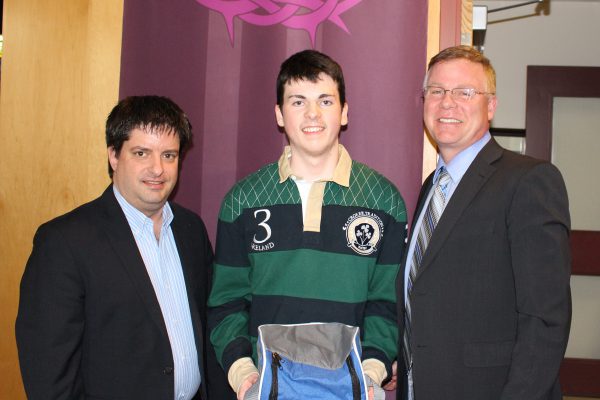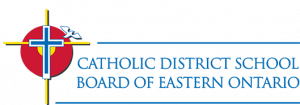Special Education Assistive Technology
Assistive technology allows all students the opportunity, regardless of their level of ability, to access the curriculum set out by the Ontario Ministry of Education, and reach their full potential. The more normative technology use becomes in the classroom, the less stigmatized students with special education needs feel when they access technology to support their learning.
Heather Gerber, Principal of Special Education, Corey Kalsi, Assistive Technology Coordinator of Special Education, and Aidan Conners, a student from St. Michael Catholic High School, presented information on how assistive technology has contributed to great learning successes for students across the Board.
“Technology has always been a very important part of education, and many of our students benefit from technology in the classroom. The Special Education Technology Enhanced Learning Tiered Model of Support demonstrates that assistive technology is necessary to support learning for some of our students, and as we move up the support continuum, we see that for a few students, adaptive technologies are essential for learning,” began Heather Gerber, Principal of Special Education. “As we continue to learn more and more about technologies, the more normative technology becomes in the classroom, the less stigmatized our students with special needs feel. This practice helps build an equitable and inclusive learning environment.”
Aidan Conners, who will be studying performing arts at Algonquin College in the fall, shared his story of how assistive technology helped to support his learning journey.
“I had a lot of challenges going into elementary school, which made learning very difficult for me. One of my challenges is described as dysgraphia, which means that I don’t take verbal instructions very well. Writing is also a challenge, and at times I have a hard time reading my own writing. Time management and self-organization is also difficult for me, for tests and projects. At times, I feel I have to take on the project in one go, which usually frustrates me and tires me out, and so I have to reach out to my parents and people from guidance to help me. My challenges made school work very, very hard.”
Aidan noted that teachers would sometimes become frustrated because of his inability to understand the work that was being assigned. Thankfully, assistive technology has solved many of Aidan’s challenges, and made him confident to move on to college. Aidan’s main technology is his iPad for school work.
For reading, Aidan uses e-Textbooks, which allows the iPad to read the text to him in an efficient and clear way. The software also allows for definitions to be quickly available for words he may not understand. In addition, Aidan has the ability to copy and paste text into an electronic worksheet, so that he has a clear reminder of answers to assignment questions.
For writing, Aidan uses speech (voice)-to-text technology on his iPad. Through his Pages app, Aidan is able to speak into the iPad and have his voice converted automatically to text in an efficient way.
“It doesn’t correct the grammar, so this is also a good learning opportunity for students who have a hard time with grammar and spelling,” he noted.
The iPad camera is an app that Aidan used in grade 9 to help overcome challenges with handwritten assignments. By scanning worksheets and turning them into electronic documents, the app allowed Aidan to then type his answers into the page.
“This however is not a problem for me anymore, as my writing has gotten much better, but for people who have a very difficult time writing I suggest this for both the student and the teacher, who is then more easily able to understand the answers,” he explained.
“Assistive Technology has been an important part of my success. I don’t believe I would be going to college in the fall if it wasn’t for these tools. I think the moment I entered high school, that’s when my real education started. I think about it every day that, I’m a guy that they said wouldn’t pass high school, and now I’m going to college. I was on the honour roll three times in a row. From a guy who didn’t pay attention in class and, who didn’t even want to go to school, who could imagine I could succeed?”
Aidan thanked his parents and the teachers and guidance staff who helped him on his learning journey.
The trustees expressed their gratitude to Aidan for sharing his story.
“Thank you so much for coming to speak to us. I think part of your performance should be a road show across our Board to speak to students and educators, because you’re a real inspiration. I wish you every success at Algonquin College,” stated Trustee Nancy Kirby.
Trustee Sue Wilson noted, “For you to be able to present here tonight for all of us, and to our subcommittee at SEAC, is a true testament to how you have tackled your learning challenges. I know your teachers are extremely proud of you, and you have shone the light for other students to follow your lead.”
“Some of the applications you use, these are applications that we use on a regular basis, but you went beyond that to show us what potential they have for students and learning. I think, moving forward, we will see the use of that technology in a different light – how it helps students succeed the way you have succeeded,” noted Trustee Laton.
Board Chair Todd Lalonde commended Aidan for his eloquence. “As you spoke, it is obvious that your confidence level is tremendous, and your thoughtfulness with regard to the people that have helped you along the way is astonishing for a young man. You are certainly a powerful advocate for all those who are finding success through technology.”
Assistive Technology Coordinator Corey Kalsi concluded the presentation with highlights of how other students have benefitted from assistive technology. Specifically, how students who would otherwise have limited opportunities with reading and writing are able to express, communicate and demonstrate their learning through technology.
Secondary students in the Living and Learning program at Holy Trinity in Cornwall have been able to create a stop motion video project using iPads. The project had students create art by building characters and animals with toilet paper rolls which were then used to create a stop motion video about the story of Noah’s Ark. The students took photos to create their story, planned the narrative, and even held auditions for the voiceover of God.
“Students at St. Mary Catholic High School experimented with “app smashing” – using multiple apps to support and demonstrate their learning. They added images and documented their learning experience in a cooking lesson using iMovie, pictures, and PicCollage. The collage provides an overall snapshot of the learning experience and the successes of this activity by engaging a group of learners with a variety of learning needs and strengths,” explained Mr. Kalsi.
“This is a very exciting journey for our learners, and I am pleased to share it with you. We are excited to continue this journey, as we incorporate assistive technology that is essential for a few, necessary for some, and of course, good for all.”

